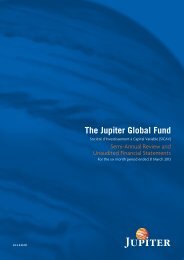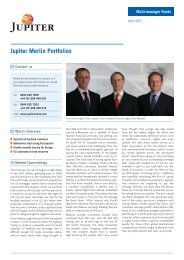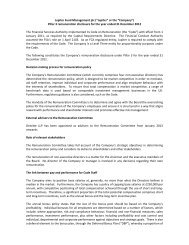The Jupiter Global Fund - Jupiter Asset Management
The Jupiter Global Fund - Jupiter Asset Management
The Jupiter Global Fund - Jupiter Asset Management
You also want an ePaper? Increase the reach of your titles
YUMPU automatically turns print PDFs into web optimized ePapers that Google loves.
the jupiter global fund<br />
<strong>Jupiter</strong> China Sustainable Growth<br />
■■<strong>Jupiter</strong> China Sustainable Growth Review of Portfolio as at 30 September 2012<br />
Performance<br />
NAV 30.09.12 30.09.11 % Change<br />
Class L US Dollar Shares USD 7.25 USD 6.21 16.75%<br />
Class L Euro Shares EUR 7.48 EUR 6.11 22.42%<br />
Class L Sterling Shares GBP 7.24 GBP 6.48 11.73%<br />
Market Review<br />
For most of the year under review, Chinese equities continued to see<br />
a two-speed market whereby a small number of large-cap dividend<br />
paying stocks became increasingly overvalued as investors sought<br />
protection from slowing earnings growth. Meanwhile, mid and smallcap<br />
growth stocks fell and are now trading at around their lowest<br />
valuations in the last 10 years.<br />
China’s pace of economic growth clearly slowed over the course of the<br />
period, in response to various policy brakes applied by the authorities to<br />
curb rising inflation. Having seen small and mid-sized enterprises<br />
struggle to meet working capital requirements as credit was drained<br />
from the financial system, the People’s Bank of China began to reverse<br />
its monetary policy in November 2011. <strong>The</strong> central bank has reduced<br />
the amount that it requires banks to hold in reserve, encouraged loan<br />
origination and cut policy interest rates twice since then.<br />
While it is tricky to predict when the Chinese economy may reach<br />
inflection point, evidence suggests that monetary and fiscal stimulus<br />
measures are producing some effect. In addition, consumer activity<br />
has remained resilient with retail sales rising by a real rate of 11.4%<br />
during the first eight months of 2012, compared to 11.3% over the<br />
same period of 2011.<br />
Policy Review<br />
Over the year to 30 September 2012, the <strong>Fund</strong> returned 16.8% in US<br />
dollar terms, compared to 8.0% for its peer group, the FO Equity<br />
China, and 21.4% for its benchmark, the MSCI ZhongHua index.<br />
<strong>The</strong> <strong>Fund</strong>’s performance was adversely affected by investors’ risk<br />
aversion and flight to the perceived safety of large-cap stocks. Our<br />
underweight stance in large-caps, especially in the financial sector,<br />
detracted from performance. In line with our investment strategy, we<br />
did not hold large Hong Kong property developers such as Cheung<br />
Kong and Sun Hung Kai and banks including Bank of China which<br />
outperformed during the period.<br />
Although our overweight stance in the mid and small-cap sectors was<br />
detrimental for performance, good stock selection among them offset<br />
the negative impact of the asset allocation. In particular, some of the<br />
portfolio’s resources and industrial holdings made strong contributions<br />
to performance. Environmental protection company China Everbright<br />
International, gas distributor China Gas, Hollysys Automation<br />
Technologies, China Oil & Gas, ERA Mining Machinery and railway<br />
trains maker CSR all added value. Among our technology holdings,<br />
AAC Technologies, a supplier of acoustic components for smart phones<br />
and tablet PCs, outperformed on the back of strong earnings results.<br />
In terms of transactions, we locked in profits in resources and industrial<br />
shares that had performed strongly. <strong>The</strong>se included China Gas, China<br />
Oil & Gas, ERA Mining Machinery and CSR. As the year progressed,<br />
we reduced our underweight stance in the financial sector, acquiring<br />
selected stocks that we believe will benefit from China’s looser<br />
monetary policy and stimulus measures. We initiated positions in<br />
Hang Lung Properties and China Construction Bank.<br />
Outlook<br />
<strong>The</strong> recent results season brought some better news, with profit<br />
margins delivering positive surprises thanks to falling input prices.<br />
Against the weak economic backdrop, this trend is expected to<br />
continue as inflation remains muted. Meanwhile, consensus GDP<br />
figures continue to fall followed inevitably by cuts in analysts’ earnings<br />
forecasts. Much of this, however, appears to be already reflected in<br />
share prices.<br />
We expect a modest recovery in economic growth over the balance of<br />
the year. With the manufacturing purchasing managers index showing<br />
some improvement, we expect to see a pick-up in output in the fourth<br />
quarter against a continuing backdrop of benign inflation.<br />
<strong>The</strong> 18th Party Congress is scheduled to commence on the 8th of<br />
November after which we will start getting more clarity as to the<br />
make-up of the next ruling elite and any refining of their policies.<br />
Coinciding with this important period of leadership change, we expect<br />
the Chinese authorities to ease their monetary policy further and<br />
introduce more stimulus measures. We expect the recent polarisation<br />
of the market in favour of large-cap stocks to reverse sharply when the<br />
macro backdrop begins to improve.<br />
Philip Ehrmann<br />
30 October 2012<br />
75








